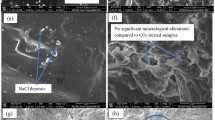Abstract
Carbon dioxide (CO2) storage in aquifers or injection to petroleum reservoirs for enhanced oil recovery purposes are the ways of mitigation of global warming. Dissolution of carbon dioxide in water forms carbonic acid. This acid would react with the carbonate components in carbonate rocks (i.e., CaCO3, MgCO3) and cause dissolution of salts thereafter changing carbonate rocks intrinsic properties. Dissolution changes the properties of carbonate rocks. To investigate these phenomena, two carbonate rock samples were saturated with brine and brought in contact with carbonated water for about 12 days. After each 72-h period, porosity, permeability, the mass of the cores and concentration of released ions in brine were measured. Concentrations of released ions were calculated by titration in each period. A considerable change on rock properties was observed. Porosity and permeability changes were about +8.09 and ±9.73 %, respectively, and core weight loss was about 0.82 Wt %. Besides, intensity of the concentration of released magnesium ions in brine with comparison to calcium ions indicates that the core samples are dolomite. The results of this study show that carbonate rock dissolution should be considered in water alternative CO2 injection, carbonated water injection and CO2 storage projects.










Similar content being viewed by others
Abbreviations
- D:
-
Core diameter (cm)
- K:
-
Permeability (m2)
- L:
-
Core length (cm)
- M:
-
Core weight (gr)
- P:
-
Pressure (MPa)
- T:
-
Temperature (°C)
- Vp :
-
Core pore volume (cc)
- φ:
-
Porosity (%)
References
Amirshahkarami M, Vaziri-Moghaddam H, Taheri A (2007) Sedimentary facies and sequence stratigraphy of the Asmai Formation at Chaman-Bolbol, Zagros basin, Iran. J Asian Earth Sci 29(5):947–959
Aqrawi AAM, Keramati M, Ehrenberg SN, Pickard N, Moallemi A, Svana T, Drake G, Dickson JAD, Oxtoby NH (2006) The origin of dolomite in the Asmari Formation (oligocene-lower miocene), Dezful embayment, SW Iran. J Petrol Geol 29(4):381–402
Bacci G, Korre A, Durucan S (2011) An experimental and numerical investigation into the impact of dissolution/precipitation mechanisms on CO2 injectivity in the wellbore and far field regions. Int J Greenh Gas Con 5(3):579–588
Bathurst RGC (1975) Development in sedimentology 12: Carbonate sediments and their diagenesis. Elsevier Science, Inc., Amsterdam
Grigg RB, McPherson BJ, Svek RK (2003) Laboratory and model tests at reservoir conditions for CO2/brine/carbonate rock systems interactions. Second Annual DOE Carbon Sequestration Conference, Washington, DC
Kapelke M, Caballero E (1984) Prevention of calcium carbonate precipitation from calcium chloride kill fluid in CO2-laden formations. SPE California Regional Meeting
Liu Z, Yuan D, Dreybrodt W (2005) Comparative study of dissolution rate-determining mechanisms of limestone and dolomite. Environ Geol 49(2):274–279
Luquot L, Gouze P (2009) Experimental determination of porosity and permeability changes induced by injection of CO2 into carbonate rocks. Chem Geol 265(1):148–159
Ross GD, Todd AC, Tweedie JA, Will AGS (1982) The dissolution effects of CO2/brine systems on the permeability of UK and North Sea calcareous sandstones. SPE 10685, SPE/DOE Third Joint Symposium on Enhanced Oil Recovery, SPE, Tulsa
Sayegh SG, Krause FF, Girard M, Debree C (1990) Rock/Fluid Interactions of Carbonated Brines in a Sandstone Reservoir: Pembina Cardium Alberta Canada.”. SPE Form Eval 5(04):399–405
Seyrafian A (2000) Microfacies and depositional environments of the Asmari Formation, at Dehdez area (a correlation across central Zagros basin). Carbonate Evaporite 15(2):121–129
Taylor KC, Nasr-El-Din HA, Mehta S (2006) Anomalous acid reaction rates in carbonate reservoir rocks. SPE J 11(04):488–496
Vaziri-Moghaddam H, Kimiagari M, Taheri A (2006) Depositional environment and sequence stratigraphy of oligo-miocene Asmari Formation in SW Iran. Facies 52(1):41–51
Zekri AY, Shedid SA, Almehaideb RA (2009) Investigation of supercritical carbon dioxide, aspheltenic crude oil, and formation brine interactions in carbonate formations. J Petrol Sci Eng 69(1):63–70
Acknowledgments
This work is sponsored by Department of Petroleum Engineering, National Iranian South Oil Company which is gratefully acknowledged.
Author information
Authors and Affiliations
Corresponding author
Rights and permissions
About this article
Cite this article
Abbaszadeh, M., Nasiri, M. & Riazi, M. Experimental investigation of the impact of rock dissolution on carbonate rock properties in the presence of carbonated water. Environ Earth Sci 75, 791 (2016). https://doi.org/10.1007/s12665-016-5624-3
Received:
Accepted:
Published:
DOI: https://doi.org/10.1007/s12665-016-5624-3




